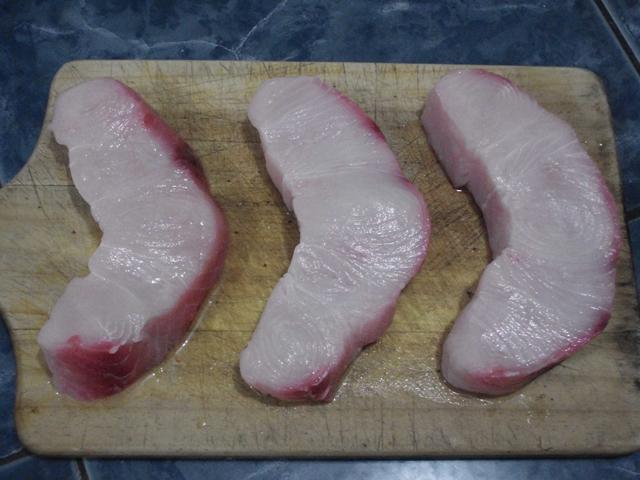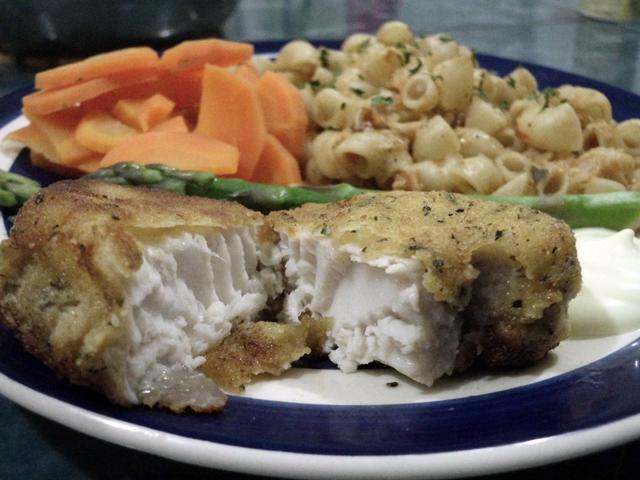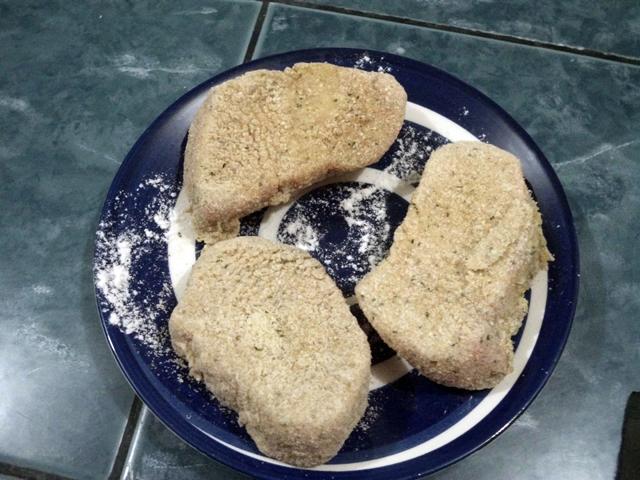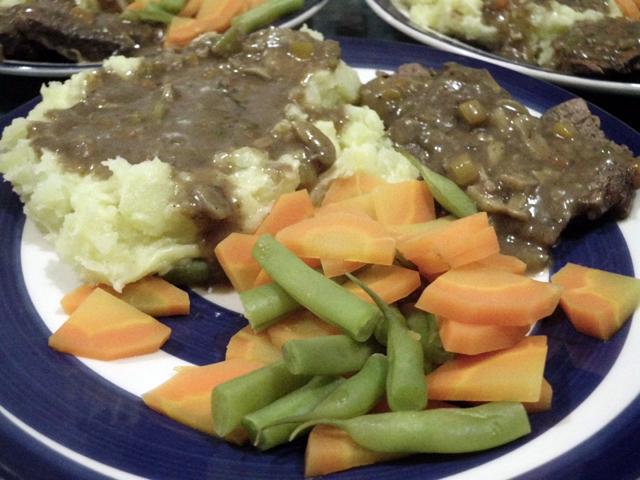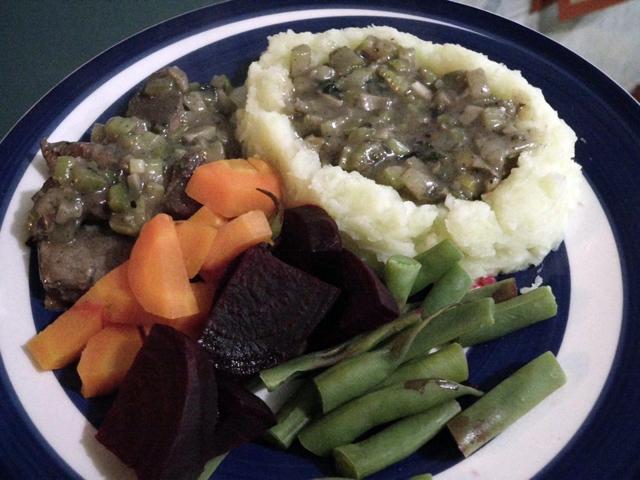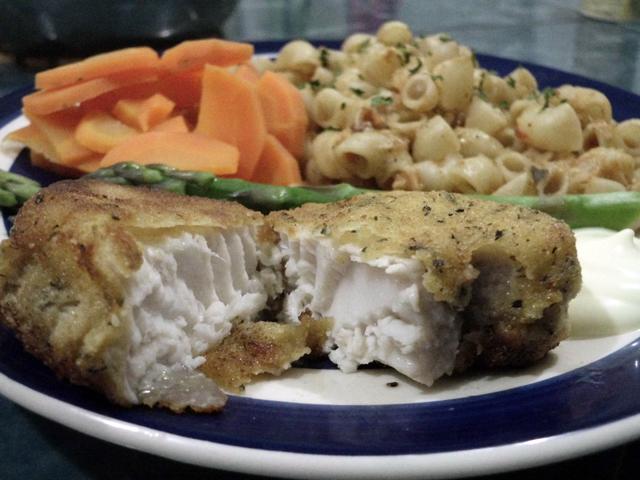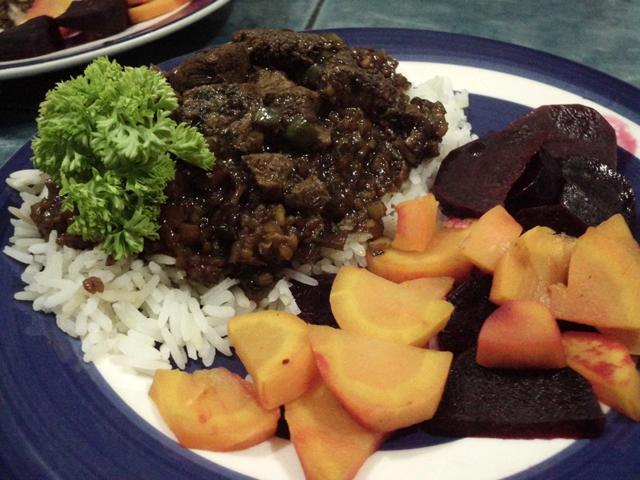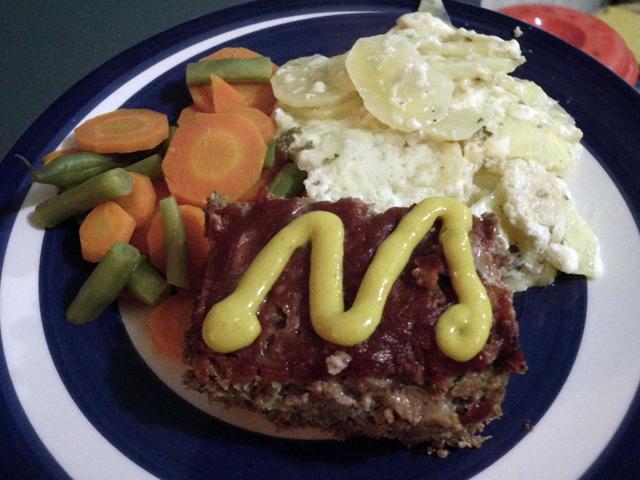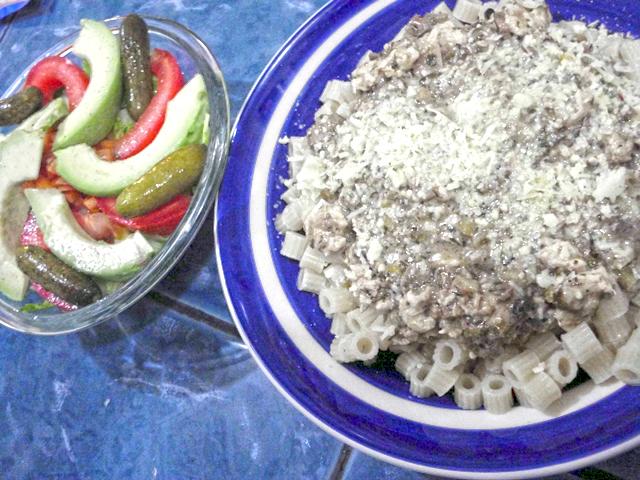-
Posts
2,383 -
Joined
-
Last visited
Content Type
Profiles
Forums
Store
Help Articles
Everything posted by Panaderia Canadiense
-
Well, as Rab Burns once said, the best laid plans of mice and me(n) gang aft agley…. I got back to the fish market last weekend and what really tempted my tastebuds was another crack at Cazón de Leche - the prawns were too expensive for last week's budget... Upthread where I first tried this shark, I was underwhelmed by its texture and resolved to try breading and frying it to see if that made it any less mushy, mouthfeel wise. Ecuadorian name: Cazón de Leche English name: Soupfin Shark (among others) Size: 3 steaks totalling to 900g, which I divided for two meals. The steaks. Our fishmonger of choice was lovely enough to remove the skin for us and divide them up. I hope to get a photo next time I'm back - for dividing large steaks and breaking down tuna, he uses a blade called a Pombo, which looks more like a medieval halberd than anything…. Floured, egged, and breaded Dish one, with a side of pasta tossed in tomato sauce with parmesan cheese. Dish two, on a bed of pasta with mushroom cream sauce. I can now say that I definitely prefer Cazón cooked this way - the pan-frying with breading seems to help prevent overcooking or undercooking, and the texture this time was firm and pleasant, the way a medium-rare beef steak is (and this is the texture I go for when cooking shark).
-
Amazing meals from everyone! Here's the highlights of my past couple of weeks (when I'm not eating cuppa-noodles, that is…) I am absolutely green with envy at the ingredients some of you can get your hands on…. Beef stews of some sort, over cheesy mashed potatoes. Obligatory carrots. The first two are estofado styles, and the third is a seco. Meat overload pizza on quinua-herb focaccia crust with Andina and Javierino cheeses. This was excellent but so heavy it put all of us to sleep. Two presentations of Cazon de Leche, a type of shark that runs in our waters. About this more in the Ecuadorian Fishery thread; the steaks were dredged in spiced flour, egged, coated in spiced breadcrumbs, and fried in the bare minimum of sunflower oil. Beef Teriyaki. This one was really good. Ye olde standby of comfort food, meatloaf, with cheesy scalloped potatoes. And a sort of deconstructed Chicken Cordon Bleu re-imagined as a pasta sauce, using ground chicken and ham shreds in white-wine mushroom cream sauce. It looks kind of like the cat's hangover, but it was delicious.
-

eG Foodblogs: Coming Attractions 2012 & 2013
Panaderia Canadiense replied to a topic in Food Traditions & Culture
Inland by some 300 km, actually. -

eG Foodblogs: Coming Attractions 2012 & 2013
Panaderia Canadiense replied to a topic in Food Traditions & Culture
Someone with a CSA or a garden, looks like. Shelby, perhaps? That looks like her kind of haul…. -
As a recipe writer, I find it's difficult sometimes not to specify a particular brand of an ingredient, if I think it's going to make a big difference in the way the recipe will turn out. But in that case I always try to explain why, and if possible give other options. For instance, I use Valentina brand Mexican hot sauce in a several recipes, so I say that, but I also give a couple other brand names and just say that if my readers use anything else, they may have to adjust the acid level, because that can affect the results. There's a big difference when the writer of the recipe gives their reasons for the specificity (I do this myself) but when it's just put there for what seems like the sake of advertising and little else (the butter I cited in that quote is a good example - it's a standard 85% butterfat product) is when it irks me most. If there's a rationale behind things, like Jersey cream or Guernsey cream, which do have different flavour and fat contents from "standard" cream, then it's not such an issue.
-
I react in the same way as you do to recipes written in this way - I feel that the author is condescending to me or subtly trying to make me feel like an inadequate cook if I don't have the exact ingredients mentioned. The same thing goes for recipes that call for specific brands of things (500g of Pura Crema butter, e.g.) I'm actually less inclined to even try a recipe when it's written in this manner. I think it's probably something endemic to the whole "nanny state" thing that's going on in North America - it's like recipe writers don't trust us to make our own informed decisions regarding ingredients. Honestly, organic veg are normally what's in the crisper at my house, but that's a choice that I've made based on economy (at my farmer's markets, organic is cheaper than chemically treated) more than anything else. And seriously, Grassfed ghee? Gimme a break. Ghee is a clarified fat - if it's properly made, it should have no flavour other than that of butterfat, regardless of the milk source. Same goes for "organic" vs conventional oils - the only real difference is the cost.
-
I'm really fond of the simple standbys: sun salutations and downward dog. They seem to extend and realign everything that I mess up when I've got stove or countertop related back pain.
-
I use about 25% of the weight of the sugar syrup in glucose at this point; I'll try upping it a bit but not too much because I want stiffer caramels that I can wrap. It's summer here right now, and too much cold flow is a very bad thing….
-
Traditional 2-step caramel. Syrup to hard ball, then add warm cream/butter, stir like mad, cook to 235 F, then vanilla, stir, and pan. I'm at 10,000 feet of altitude, give or take about 5 feet; I've been using an 18 F adjustment with good results - the 20 F recommended for this altitude doesn't give me proper hard ball consistency - it doesn't carry far enough, especially with the brown sugars. ETA - Do you think a Maillard caramel would work this way? I make my own cajeta, manjar, and dulce de leche, but I've never tried to thicken it far enough to make "proper" chewy caramels…..
-
Ginger is incredibly persistent - it carries through when I caramelize the same syrup for certain IMBC types, so I'm not that worried about loss or masking of flavour.
-
OK, but what I've got is an excess of heavy ginger syrup - it's a byproduct of candied ginger, and I can only use so much of the stuff for my own ginger-ale and whatnot. So, rather than infusing the cream, I've pre-infused the sugar component, if that makes sense. I'm gratified that you think they'll be tasty, though - it's always good to have a second opinion. So here's a fresh question: since I'm not infusing the cream (it's a waste of ginger for me) but rather starting with a pre-infused syrup of approximately the right ratio according to my gran's caramel recipe (which is my gold standard, and calls for 2.5:1 brown sugar:water - I'll be adding just a hint more sugar to bring it up to par), it should be as simple as bringing the pre made syrup up to temperature, then adding the warm butter/cream mixture? I'll be giving this a bash probably at the next weekend - I'll definitely post back with results! EDIT: should I be salting these, or just try salting half?
-
OK, so here's a question for all of you confectionary gurus: do you think it would be a terrible waste of my ingredients to try making ginger caramels using a panela-ginger 2:1 sugar:water syrup as my sugar base? Would they turn out the way I'm imagining, which is chewy creamy gingery goodness, or would it just be a pan full of awful yukk and a frustration? If you think it would work, what proportions of syrup to cream should I be looking at? Is there anything else I should be adding? And finally, I normally shave 18 F off of my boiling temperatures to account for my extreme altitude - I should do the same with these, yes? Thanks in advance.
-
Panaderia, you just soak the barley at room temp for barley water? You don't boil it? Perhaps you might also find this interesting: http://www.mummyicancook.com/2012/09/old-fashioned-barley-water.html I usually soak overnight, then if the water seems weak I boil in the morning. However, the grade of pearl barley available to me here in Ecuador (where they look at me like I'm nuts because the only reason to buy pearl barley is to roast it for Machica, and since that's widely available why in the world would you do that?) has a lot of extra starch on it - it's never been rinsed. Overnight soaking is usually sufficient, and then the barley goes into the Scotch Broth with the accumulated week's lamb bones. If I boil before adding the barley to the broth, I lose the lovely velvety texture I mentioned above, and the thickening doesn't seem to be as strong. If I want barley water like what's mentioned in your link, I use Arroz de Cebada, which is cracked pot barley - mmm, gluten-y and yummy!
-
Pearl barley also releases its gluten faster than hulled (pot or Scotch) or groat barley (one of which is what Porthos is talking about - both preserve the bran, but in different ways). Pearl, with no bran at all on it, imparts a really excellent velvetty texture and thickening to soups where it's included. It's also subtly chewier than other barleys and in soup contexts it can cook faster. I still soak it overnight, but more because I like the resulting barley water as a refreshing drink....
-
Fresh in the crisper at the moment: celery, mushrooms, lettuce, zucchini, avocados that are ripe and that I will not eat today, beets, red and green peppers, asparagus, peas, garlic and shallots, Romanesco and broccoli and cauliflower, green beans, cucumbers, and probably a couple of other more esoteric veggies that I'm not recalling at the moment. I've also got carrots and potatoes, *edit* and a few kinds of onions, but they are not fridge items. Canned veg, apart from perhaps creamed corn, is an abomination. Same goes for frozen, with the very possible exception of peas (although I still prefer fresh) is in the same boat. IMHO, at least.
-
Rotuts/gfweb: it's not an inulin/inulase reaction with epazote (no extra s in the name), it's a carminative action due to the volatile oils present (which are similar in structure to those of fennel/anise and tarragon) that causes you to burp more often (and fart less) and therefore release the gasses produced by the inulin in your digestive system in a less noxious way.
-
I put a few leaves of fresh Paico, also known as Epazote, into the pot when I cook beans. Voila, no gas. I generally cook beans from fresh, though, not from dried. Of course, it's also a common garden weed in my neck of the woods....
-

Eat it Because It's Good For You
Panaderia Canadiense replied to a topic in Food Traditions & Culture
I eat basically whatever I want, in moderation. Mom used to use oatmeal in particular as an "eat it, it's good for you" thing, but I've always liked it regardless. However, I'm more likely not to eat something that somebody hands me and says "eat it, it's good for you" - well, yeah, it might be but you just put me off it by trying to sell it that way. I'm more likely to try it if you tell me "eat it, it's yummy." -
Looking at mine, they are more bell-bottomed than Porthos' pan, but according to dad, both are still sauciers in the sense that they are meant for sauces and some light poaching rather than frying.... Hmmmmm.....
-
That's a medium saucier, or at least that's what my dad, who is a cordon-bleu trained chef, calls them. I've got two of them, and they are hands-down my favourite pans for most cooking.
-
For sandwiches that I will not share with another but which seem to be too tall to just smush and bite, made on regular squarish-loaved breads, I cut on the diagonal (ensuring that one half has all of the crusty top-crust goodness, and another all of the squishy bottom-crust goodness). If I will be sharing the sandwich, I cut two equal rectangles vertically so as not to cheat the other eater out of any aspect of the crust dynamic. For sandwiches on things like bagels or round breads, I don't cut them at all. It's not necessary! For finger sandwiches or other hors d'oeuvre sandwich type things, I use decorative cutters like Annabelle mentions. So, no, I don't think there's one right way. Clearly there are at least three right ways!
-
I'll try to get something up this weekend - I'm a baker, which means that Difuntos is one of the busier times of the year....




